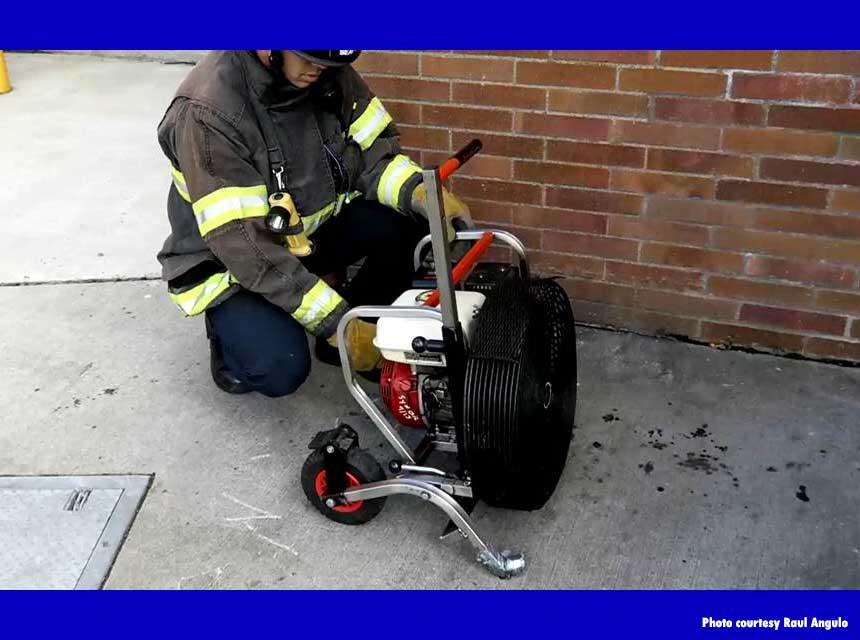The Fundamentals of PPV Use for Firefighters
The positive-pressure ventilation (PPV) fan is a great tool to have on the fireground for postfire ventilation. It will provide ventilation by ways of pressurizing the inside of the structure and “pushing” or “forcing” smoke out of the structure. Smoke likes to live in low-pressure zones and when a structure is made to be a high-pressure zone, the smoke will want to seek out the low-pressure areas and go there—this is basically how the positive pressure ventilation fan works. The main key to this operation is for the firefighters to completely extinguish the fire prior to introducing the fan for ventilation purposes.
- Drills You Won’t Find in the Books: The Dancing PPV Fan Drill
- Video: Pressurization Technique for Clearing Smoke
- Research for the Fire Service: Positive Pressure Ventilation
- USING ELECTRIC FANS FOR PPV
For it to work effectively, there needs to be an opening and an exit. The opening can be a door or a window with the exit being of equal size or larger. The exit needs to be the same size or larger so that it can accommodate the volumes of smoke exiting the structure. Having more than one opening or exit will only compromise the operation and effectiveness of the fan, as the structure will not be able to become a high-pressure zone. In essence it becomes like a piece of Swiss cheese, full of holes. A common mistake made on the fireground is to introduce the fan once all windows have been taken out and all doors are open. Have only one opening and only one exit and the fan will work for you effectively. If all the windows are open and taken out, then another method of postfire ventilation will need to be used.

To obtain the pressurization of a structure, the air current being created by the fan needs to surround the opening of the structure. An air seal is created around the door or window when the cone of air from the fan completely covers the entire opening. When there is not a complete seal around the opening, complete pressurization will not take place.
So how do we ensure that the opening is completely covered? Take your hand and place it at the upper corners of the opening to feel for any air current coming from the fan. If you feel the air, then you have a good cone of air surrounding the opening. If you don’t feel anything, you will need to adjust the fan to obtain the cone.
No matter what brand positive pressure fan your fire department has, it will have the same generic principle of operation. There will be a motor, either electric or gasoline powered, attached to a frame body that will power and turn the fan blades. The fan blades will be protected by a metal shroud which will prevent and body parts or foreign objects from coming into contact with the blades.
The blades of the fan are made from a plastic material strong enough to withstand the high-speed revolutions and air current production. The danger is that the blades can break under stress when the fan is being moved while it is running. When it has to be adjusted, the fan will be moved either forwards or backwards to obtain the proper cone. When the fan is being moved, there are stresses being created on the shaft of the blades that are not supposed to be present when the fan is running. The sudden jerking of the fan body can cause the shaft to break and throw the fan blades out of control. Even though there is a protective shroud around the blades, it will not guarantee containment. If you must move the fan, shut it off, then move it.
Equipment needed: Access to a structure of any type and a PPV fan.
Goal: To become proficient with setting up and running PPV operations.
Drill.
- Select a building to use to set up PPV operations. This can be the fire station or any building that the fire department has access to. Be sure it has a front and back door of equal or bigger size
- Grab the department PPV fan and bring it to the location for set up.
- Select the main entry point for the fan to be set up while another member looks for the exit point of equal or larger size
- Once the fan is in place, start the fan up and measure for the cone of air around the door opening. Make sure to face away from the fan when measuring with your hand at the corners to avoid getting any debris in your eyes from the blades.
- Adjust the fan by turning it off to capture a complete cone around the door.
- Once the cone is established, communicate with the other member to open the exit point, and feel for the air exhausting out.
- Once completed, shut down the operation, reset the building and the fan and other crew members do the same thing.
Key points:
- The exit opening must be equal to the entry point or larger to accommodate the exhausting gases/smoke.
- Face away from the entry point fan when measuring to protect the eyes and face from flying debris.
- Turn off the fan when adjusting/moving it for a better position to capture the cone around the opening.

Mark van der Feyst has been in the fire service since 1999 and is a firefighter with the Fort Gratiot (MI) Fire Department. He is an international instructor teaching in Canada, the United States, and India, and at FDIC. He is also the lead author of Residential Fire Rescue (Fire Engineering Books & Video). He can be contacted at Mark@FireStarTraining.com.

